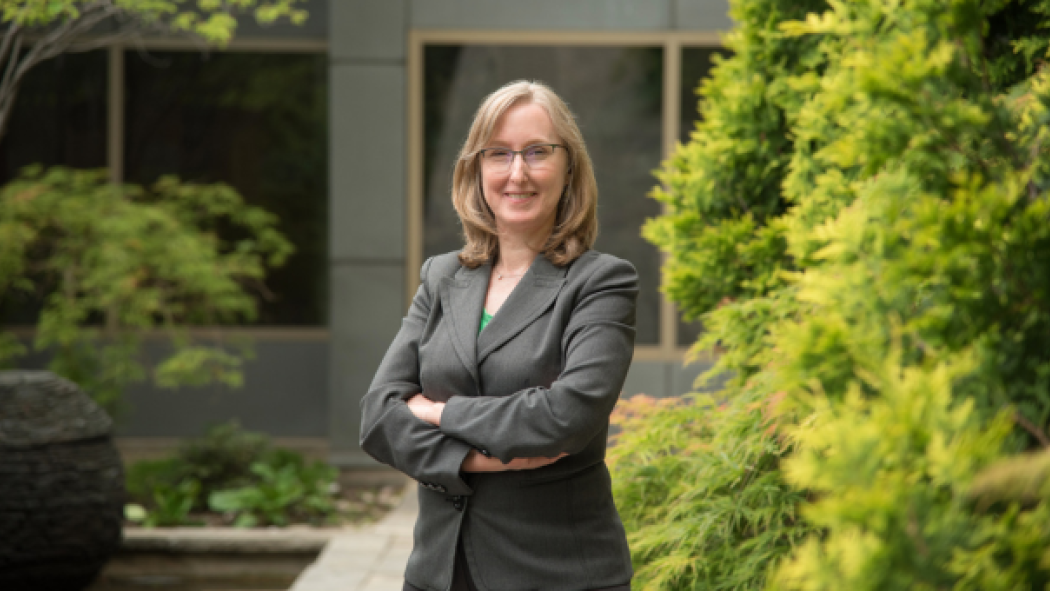
July 15, 2024
Dr. Kathleen Surry moves around a Linac bunker at the Verspeeten Family Cancer Centre with ease, explaining how the machine delivers carefully calculated doses of radiation to cancer patients. With just the touch of a few buttons, she’s able to maneuver the lifesaving equipment into any position.
“I just can’t pass up an opportunity to teach,” Surry says with humour in her voice and a kind smile as she shares more details about how the technology works.
Surry’s passion for her work as a clinical medical physicist is clear. She’s spent the last 20 years as a member of Team LHSC, working alongside her colleagues in radiation oncology to craft and meticulously vet precise treatment plans, ensuring they’re as safe and effective as possible.
If you were to think of a radiation treatment plan as a blueprint for a building under construction, medical physicists would be the architects helping to map out the design and embed safety features. Patients may not meet the medical physicists on their care team, but they pore over their treatment plans and are even present for some procedures.
Their work also involves the evaluation and implementation of new technologies, and driving process change in radiation therapy.
Surry’s dedication to the field led her to become the newly minted president of the Canadian Organization of Medical Physicists (COMP). She began her two-year term at the group’s helm in June during its annual scientific meeting in Regina, Saskatchewan.
Surry feels strongly about COMP’s role in advancing the future of cancer care in Canada while supporting medical physicists and attracting more people to the field.
Equity and access
During her tenure as president, Surry aims for COMP to address immediate needs impacting its membership while keeping a keen eye on the future of the profession.
Canada’s vast geography and concentrated population present a significant challenge to meeting those goals.
“There’s an interesting problem in Canada with equity and access,” Surry says. “Cancer care is expensive and very technical, so it’s often located in a big city centre with a population to support it. But how do we make sure we maintain access to quality care for all?”
Surry says COMP’s membership should have the resources they need no matter their location.
“We want to make sure someone in a rural area has the tools needed to practice at the same level of quality as someone in Toronto or another large city.”
COMP’s mission and vision have been refocused on patient-centred care while supporting and amplifying the group’s membership. Much of that work is underpinned by questions of equity, Surry says.
Previously the Chair of COMP’s Women’s Committee – Inclusion, Diversity, Equity and Accessibility (CWC-IDEA), Surry says she remains focused on recruiting more women and people from communities that have been historically marginalized.
She notes women only represent about 30 per cent of COMP’s membership and there are only three women working as medical physicists at LHSC.
“I was the only woman physicist working in the department for about 15 years, so we're still not a very common sight in physics,” says Surry. “I'm really proud of bringing the contributions of women in science to the forefront.”
Team LHSC leading the way
Surry is the latest member of the team at the Verspeeten Family Cancer Centre to join the leadership of their respective professional group. Dr. Stephen Welch recently was named president-elect of the Canadian Association of Medical Oncologists while Dr. George Rodrigues is president-elect of the Canadian Association of Radiation Oncologists.
“It’s quite a story of London leading the cancer scene across Canada,” Surry says. “I think that triad of us is quite remarkable and it’s fantastic London has so much influence with those groups going forward.”
The ability of the three specializations to work together augments the evolution of cancer care in Canada.
It’s a process not dissimilar to the cumulative nature of radiation treatments themselves, with the impact intensifying with each dose a patient receives.
“We amplify each other, and we can achieve so much more when we work together,” says Surry.
